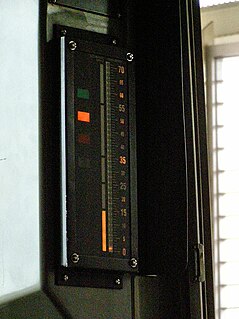
An anti-lock braking system (ABS) is a safety anti-skid braking system used on aircraft and on land vehicles, such as cars, motorcycles, trucks, and buses. ABS operates by preventing the wheels from locking up during braking, thereby maintaining tractive contact with the road surface.

A rack railway is a steep grade railway with a toothed rack rail, usually between the running rails. The trains are fitted with one or more cog wheels or pinions that mesh with this rack rail. This allows the trains to operate on steep grades above around 7 to 10%, which is the maximum for friction-based rail. Most rack railways are mountain railways, although a few are transit railways or tramways built to overcome a steep gradient in an urban environment.

In rail transport, distributed power (DP) is a generic term referring to the physical distribution—at intermediate points throughout the length of a train—of separate motive power groups. Such 'groups' may be single units or multiple consists, and are remotely controlled from the leading locomotive. The practice allows locomotives to be placed anywhere within the length of a train when standard multiple-unit (MU) operation is impossible or impractical. DP can be achieved by wireless or wired (trainlined) means. Wired systems now provided by various suppliers use the cabling already extant throughout an ECP train.

Rail terminology is a form of technical terminology. The difference between the American term railroad and the international term railway is the most significant difference in rail terminology. There are also others, due to the parallel development of rail transport systems in different parts of the world.

Cab signaling is a railway safety system that communicates track status and condition information to the cab, crew compartment or driver's compartment of a locomotive, railcar or multiple unit. The information is continually updated giving an easy to read display to the train driver or engine driver.
A wheel speed sensor or vehicle speed sensor (VSS) is a type of tachometer. It is a sender device used for reading the speed of a vehicle's wheel rotation. It usually consists of a toothed ring and pickup.

A defect detector is a device used on railroads to detect axle and signal problems in passing trains. The detectors are normally integrated into the tracks and often include sensors to detect several different kinds of problems that could occur. Defect detectors were one invention which enabled American railroads to eliminate the caboose at the rear of the train, as well as various station agents stationed along the route to detect unsafe conditions. The use of defect detectors has since spread to other overseas railroads.

An axle counter is a device on a railway that detects the passing of a train between two points on a track. A counting head is installed at each end of the section, and as each train axle passes the counting head at the start of the section, a counter increments. A detection point comprises two independent sensors, so the device can detect the direction and speed of a train by the order and time in which the sensors are passed. As the train passes a similar counting head at the end of the section, the system compares count at the end of the section with that recorded at the beginning. If the two counts are the same, the section is presumed to be clear for a second train.

Positive train control (PTC) is a system of functional requirements for monitoring and controlling train movements and is a type of train protection system. The term stems from control engineering. The train is only allowed to move in case of positive movement allowance. It generally improves the safety of railway traffic.
Wheel slide protection and wheel slip protection are railway terms used to describe automatic systems used to detect and prevent wheel-slide during braking or wheel-slip during acceleration. This is analogous to ABS and traction control systems used on motor vehicles. It is particularly important in slippery rail conditions.
Electronically controlled pneumatic brakes are a type of modern railway braking system which offer improved performance compared to traditional railway air brakes.

Advanced Civil Speed Enforcement System (ACSES) is a positive train control cab signaling system developed by Alstom. The system is designed to prevent train-to-train collisions, protect against overspeed, and protect work crews with temporary speed restrictions. The information about permanent and temporary speed restrictions is transmitted to the train by transponders (Balises) lying in the track, coded track circuits and digital radio. It was installed beginning in 2000 on all of Amtrak's Northeast Corridor between Washington and Boston, and has been fully active since December 2015, a few months after the 2015 Philadelphia train derailment which it would have prevented.

Pulse code cab signaling is a form of cab signaling technology developed in the United States by the Union Switch and Signal corporation for the Pennsylvania Railroad in the 1920s. The 4-aspect system widely adopted by the PRR and its successor railroads has become the dominant railroad cab signaling system in North America with versions of the technology also being adopted in Europe and rapid transit systems. In its home territory on former PRR successor Conrail owned lines and on railroads operating under the NORAC Rulebook it is known simply as Cab Signaling System or CSS.

A train inspection system is one of various systems of inspection which are essential to maintain the safe running of rail transport.
Quester Tangent Corporation (QTC) is an independent North American supplier of train electronics and software for the rail transit industry. Quester Tangent designs, develops and manufactures vehicle monitoring hardware and software for the global rail transit industry, including monitoring and control products, on-train displays, communication and data networks, and passenger information systems.
Faiveley Transport, formerly Faiveley, is an international manufacturer and supplier of equipment for the railway industry founded in 1919. It introduced the single-arm pantograph in 1955. The company has subsidiaries in more than 24 countries. The majority of Faiveley Transport's outstanding stock is owned by Wabtec Corporation, which acquired majority stock ownership from the Faiveley family in 2016.

Stemco is a Longview, Texas, based company that manufactures and distributes products for the global commercial vehicle market. Its major product categories include wheel end products, brake products, intelligent transportation systems and suspension components.

GE Oil & Gas was the division of General Electric that owned its investments in the petroleum industry. In July 2017, this division was merged with Baker Hughes.














